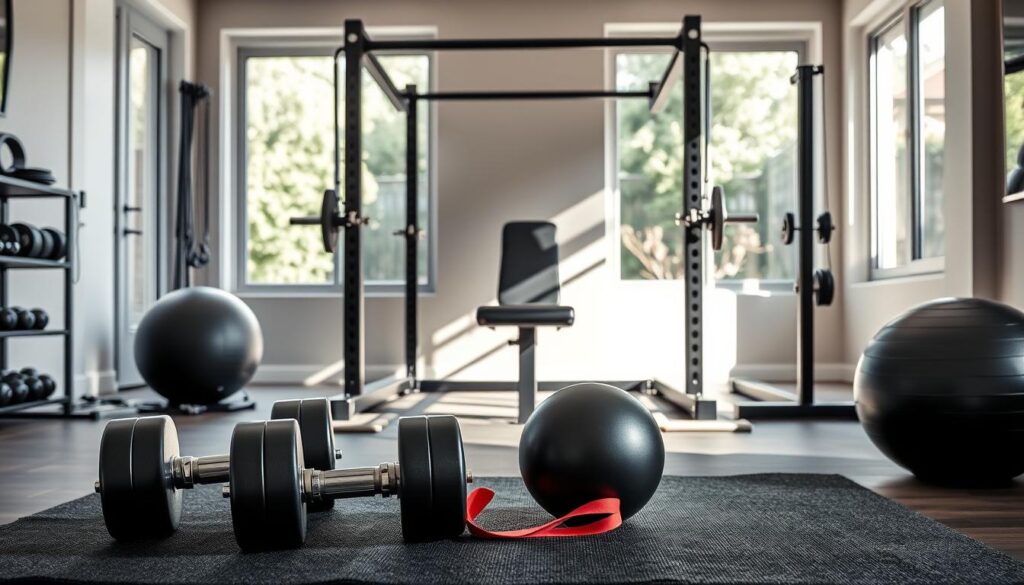Exercises: How to Build Strength in Just 20 Minutes a Day
Table of Contents
Imagine changing your body and mind with just 20 minutes of exercise each day. Strength training isn’t about spending hours in the gym. It’s about smart, targeted exercises that give you big results in little time.
Your fitness journey doesn’t need endless hours of exercise. Modern research shows that smart strength training can greatly improve your health. By choosing efficient workouts, you can build muscle, boost your metabolism, and feel better—all in just 20 minutes a day.
The secret is in exercises that work many muscles at once. Whether you’re busy or love fitness, 20-minute strength training sessions can change how you see exercise and health.
Key Takeaways
- 20-minute workouts can effectively target multiple muscle groups
- Strength training improves physical and mental health
- Bodyweight exercises offer flexible fitness options
- Consistent short workouts yield significant health benefits
- Efficient exercises can boost metabolism and muscle growth
To get better results, you can benefit from the benefits of this nutritional supplement
Understanding the Power of Daily Strength Training
Strength training is more than just building muscles. It can change your body and mind in just 20 minutes a day. These programs are made to help you reach your best while fitting into your busy life.
Daily strength training is a full-body wellness approach. It affects many parts of your health. Studies show it can greatly improve both your body and mind.
Physical Health Advantages
- Increase muscle mass by 0.5–2 pounds per month
- Reduce risk of falls, especially for older adults
- Improve heart function and lower blood pressure
- Enhance metabolism and fat burning
Mental Health Benefits
Strength training does more than just change your body. It also has big mental health benefits:
- Decrease depressive symptoms
- Reduce anxiety
- Improve cognitive functions
- Enhance overall mental well-being
Time-Efficient Fitness Solutions
Your busy life doesn’t mean you can’t stay fit. Just 20 minutes of daily strength training can change your health game. The CDC says to do strength training at least twice a week. These short workouts match up perfectly with what experts recommend.
“Strength training is the most powerful weapon in your fitness arsenal.” – Fitness Expert
| Training Focus | Recommended Repetitions | Sets |
|---|---|---|
| Muscle Gain | 4-8 repetitions | 3+ sets |
| Fat Loss | 8-12 repetitions | 1-3 sets |
| Muscular Endurance | 12-16 repetitions | 1-3 sets |
Getting Started with 20-Minute Workouts

You don’t need to spend hours at the gym to get fit. A 20-minute workout can help you build muscle and improve your cardio. The secret is to use high-intensity moves that work many muscles at once.
When starting, focus on quick and effective exercises. Begin with a 2-minute warm-up to get your muscles ready and avoid injuries. Aim to work out 2-4 times a week, resting for 48 hours to let your muscles heal.
- Warm-up for 2 minutes
- Complete 6 core bodyweight exercises
- Aim for total circuit of 105 repetitions
- Maintain workout duration of 20 minutes
Stretching is key to your workout. Do dynamic stretches before and static stretches after to boost flexibility and ease muscle tightness. Remember, quality trumps quantity in strength training.
| Exercise Type | Repetitions | Duration |
|---|---|---|
| Bodyweight Squats | 20 reps | 3-4 minutes |
| Push-ups | 10 reps | 2-3 minutes |
| Walking Lunges | 20 reps | 3-4 minutes |
| Plank Hold | 15 seconds | 1-2 minutes |
Keep getting better by adding more reps or harder exercises each week. Stick to this routine for 4-6 weeks. Then, try more challenging moves.
The American College of Sports Medicine confirms that a 20-minute workout can be as effective as longer sessions when executed with intensity and purpose.
Your success isn’t just about working out. What you eat matters a lot too. Diet is 80% of weight loss, while exercise is 10-20%. Eat well to get the best results from your workouts.
Essential Equipment for Home Strength Training
Setting up a home gym doesn’t have to be expensive. You can create a small, effective space for working out. This can help you lose weight and stay fit without spending a lot.

Many people find it hard to stick to a workout plan. But, working out at home can make a big difference. Studies show that 75% of people don’t exercise enough. So, having a home gym is key.
Bodyweight Exercise Options
Bodyweight exercises are a great way to start. They don’t need any equipment and can be done anywhere. Here are some examples:
- Push-ups
- Squats
- Lunges
- Planks
- Mountain climbers
Basic Equipment Recommendations
Adding these affordable tools can boost your workouts:
| Equipment | Price Range | Fitness Benefits |
|---|---|---|
| Resistance Bands | $10-$25 | Full-body strength training |
| Adjustable Dumbbells | $56-$60 | Multiple weight options |
| Stability Ball | $15-$30 | Core strengthening |
| Pull-up Bar | $20-$50 | Upper body development |
Setting Up Your Workout Space
Your home gym doesn’t need to be huge. CivicScience polling shows that exercising at home is more appealing. Aim for a 6×6 foot area for free movement and to store your gear neatly.
“The best workout is the one you’ll actually do.” – Anonymous Fitness Trainer
By choosing the right equipment and creating a welcoming space, you can improve your fitness. You don’t need to spend a lot or have a lot of space.
Exercises for Lower Body Strength
Building lower body strength is key for better physical activity and muscle growth. A 20-minute workout can boost your lower body’s performance. It does this by focusing on exercises that work many muscles at once.
Choosing the right lower body exercises is important. Here are some essential ones to add to your routine:
- Glute Bridge: Targets glutes and core muscles
- Walking Squat: Engages quadriceps and improves mobility
- Side Lunge with Twist: Enhances stability and flexibility
- Standing Leg Lift: Strengthens hamstrings and improves balance
Make sure to do these exercises right. Quality trumps quantity in strength training. Start with 2-3 sets for each exercise, doing 10-12 reps in each set.
These exercises can make your daily movements better. Studies show that regular leg workouts increase metabolism and athletic ability. Just 20 minutes a day can make your leg muscles strong and resilient.
Remember: Consistency is key in muscle building and physical development.
Pro tip: As you get better, increase the number of reps and add weights. Your body will get stronger and more capable with each workout.
Upper Body Training Techniques
To build a strong upper body, focus on strength training that works many muscles at once. A 20-minute workout can change your body shape with the right exercises. These exercises help build muscle effectively.

Good training programs balance muscle growth by using push and pull exercises. This method helps condition your upper body fully and avoids muscle imbalances.
Push and Pull Movement Fundamentals
Push and pull exercises are key in strength training. They work different muscles, making your workout well-rounded.
- Push movements target chest, shoulders, and triceps
- Pull movements engage back and bicep muscles
- Alternating between push and pull exercises promotes muscle symmetry
Essential Shoulder and Arm Exercises
For precise muscle targeting, use these powerful exercises:
- Pushups (standard and modified)
- Tricep dips
- Lateral raises
- Dumbbell overhead press
Progressive Overload Methods
Progressive overload is vital for muscle growth. Increasing workout intensity challenges muscles and promotes growth.
| Exercise | Sets | Reps | Weight Progression |
|---|---|---|---|
| Dumbbell Bench Press | 3-4 | 8-12 | Increase 2-5 pounds every 2 weeks |
| Barbell Bent-Over Row | 4-5 | 8-12 | Increase 5-10 pounds monthly |
| Overhead Press | 4-5 | 3-6 | Increase 2-5 pounds every 3 weeks |
Remember, proper form is more important than lifting heavy. Start with lighter weights to master your technique before increasing the challenge.
Core Strengthening Fundamentals
Your core is more than just visible abs. It’s a complex system of muscles that supports your entire body. A strong core gives you stability, improves your posture, and lowers the risk of back pain.
Research shows how vital core exercises are. A study in the Journal of Physical Therapy Science found that core strengthening cuts down chronic low back pain. People with stronger cores do better in movements like squats and lunges.
“Core strength is the foundation of all movement,” says fitness expert Dr. Sarah Martinez.
Now, let’s look at some key core exercises for your 20-minute workout:
- Shoulder taps
- Crunches with knees up
- Criss-cross with knee reach
- Single-leg lower and lift
- Single-leg straight toe touch
- Modified side plank
Core muscles go beyond just your abs. They include:
| Muscle Group | Primary Function |
|---|---|
| Rectus Abdominis | Trunk flexion |
| Obliques | Trunk rotation |
| Transverse Abdominis | Trunk stabilization |
| Erector Spinae | Spine support |
Try to do core exercises 2-3 times per week for 15-30 minutes. Begin with easy movements and get harder as you get stronger.
Creating an Effective Weekly Routine
Creating smart workout plans needs careful planning. Your weekly schedule should mix intensity, rest, and challenge. This balance helps you get stronger and avoid burnout.
Workout Scheduling Tips
Here are some tips for planning your workouts:
- Do 2-4 strength training sessions a week.
- Work different muscle groups on different days.
- Keep your training varied to avoid plateaus.
- Follow the CDC’s 150 minutes of moderate activity a week.
Rest and Recovery Guidelines
Rest is key in strength training. Always give your muscles 48 hours to rest before working them again. This helps prevent injuries and supports muscle growth.
| Recovery Parameter | Recommended Approach |
|---|---|
| Muscle Group Rest | 48 hours between sessions |
| Active Recovery | Light walking or stretching |
| Sleep | 7-9 hours nightly |
Progression Planning
To keep your workouts effective, gradually increase the challenge. The NSCA suggests adding 2-5 pounds for upper body and 5-10 pounds for lower body exercises when you can do two more reps.
- Change your strength routine every 3-4 weeks.
- Keep track of your performance.
- Adjust the intensity based on your fitness level.
- Aim to gain 0.5 pounds of muscle per week.
Maximizing Results in Limited Time
You don’t need to spend hours in the gym to see results. Your 20-minute strength training sessions can lead to great weight loss and heart health. The secret is to make every minute count.
Here are some tips to get the most out of your workout:
- Use high-intensity interval training (HIIT) for maximum calorie burn
- Incorporate compound exercises that target multiple muscle groups
- Minimize rest periods between sets
- Utilize resistance bands and bodyweight movements
Cardio exercises can fit right into your strength training. Short, intense bursts of activity can significantly improve metabolic rate and overall fitness. Try adding 30-second sprint intervals between strength sets to boost your heart rate and burn more calories.
“Efficiency in fitness is about smart, focused efforts, not endless hours of exercise.”
Your workout strategy should focus on:
- Performing 10-12 repetitions per exercise
- Completing 3-4 sets of each movement
- Targeting multiple muscle groups simultaneously
- Maintaining proper form throughout the session
Consistency is more important than how long you work out. A well-planned 20-minute strength training session can be more effective than an hour of random exercise. By following these tips, you’ll make the most of your limited workout time and see great results.
Tracking Progress and Setting Goals
Tracking your fitness journey is key for building muscle and losing weight. Mobile apps and wearable devices are great tools for monitoring your progress. They help you see how well you’re doing, keeping you motivated and focused on your goals.
Tracking progress isn’t just about weighing yourself. Use body measurements, progress photos, and performance benchmarks too. Apps like MyFitnessPal and Fitbit let you log your workouts. They show your achievements through graphs and charts, making your progress exciting.
Measurement Methods
Set up a detailed tracking system for your strength training. Take body measurements regularly to see muscle gain and fat loss. Take progress photos every few weeks to see your physical changes.
Use wearable devices to track your heart rate, steps, and sleep. These metrics help you understand your fitness progress.
Goal-Setting Strategies
Make SMART goals that are specific, measurable, attainable, relevant, and time-bound. Break down big goals into smaller, achievable steps. Regularly check and adjust your goals based on your progress. This keeps you motivated and improving throughout your fitness journey.
FAQ
Can I really build strength in just 20 minutes a day?
Absolutely! High-intensity workouts are very effective for building strength. Use compound movements, keep rest periods short, and focus on proper form. This way, you can see big fitness gains in short sessions.
Do I need expensive equipment to start strength training at home?
No, you can start with bodyweight exercises that need no equipment. As you get stronger, you might want to add simple tools like resistance bands or dumbbells. But you don’t need them to begin.
How often should I do these 20-minute strength workouts?
Try to do 3-4 sessions a week, with rest days for muscle recovery. These short workouts are great for busy schedules. They offer big benefits for your body and mind.
Can beginners follow these strength training routines?
Yes, these workouts are for everyone, no matter your fitness level. Each exercise can be adjusted to fit your current strength. As you get stronger, you can increase the intensity.
What are the main benefits of regular strength training?
Strength training has many benefits. It increases muscle mass, boosts metabolism, and strengthens bones. It also improves posture, reduces injury risk, lowers stress, and enhances overall health and well-being.
How do I ensure I’m using proper form during exercises?
Watch tutorial videos, practice in front of a mirror, or get help from a fitness expert. Focus on controlled movements and engage your core. Start with lighter weights or easier versions until you’re sure of your technique.
Can strength training help with weight loss?
Definitely! Strength training increases metabolism, builds muscle, and keeps burning calories after your workout. With the right diet, it’s a great way to manage weight.
How quickly will I see results from these workouts?
Results vary, but many see strength and energy boosts in 4-6 weeks. Track your progress with measurements, photos, and strength tests to stay motivated.
What should I do if I miss a workout?
Don’t worry if you miss a workout! Just get back to it as soon as you can. Being consistent over time is more important than being perfect. Missing a few days won’t stop you from getting back on track.
Are these workouts suitable for older adults?
Yes, strength training is good for all ages. But older adults should start slowly, focus on proper form, and talk to a healthcare professional before starting. This ensures safety.







